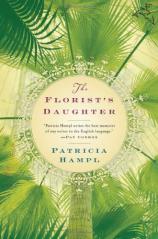The Florist's Daughter
Review
The Florist's Daughter
Patricia Hampl's newest memoir, THE FLORIST'S DAUGHTER, opens
with an indelible image. The author sits in her mother's hospital
room. At her side lies her mother, who has suffered a serious
stroke and is expected to die at any moment. In her lap lies a
yellow notepad, on which Hampl is composing her own mother's
obituary. For Hampl, whose way of dealing with the contradictions
and complexities in her life has always been to write about them
(in memoirs such as A ROMANTIC EDUCATION), writing a mini-biography
of her mother even as the woman lays dying seems a fitting
image.
Of course, as Hampl extends her mother's obituary beyond the mere
facts and figures of a long, full life, she casts her mind back to
her own memories of her mother, to those mundane but unforgettable
kitchen-table moments that form the bulk of memories but are
unlikely to appear in any sort of formal obituary.
Almost immediately, Hampl sets up a contrast between her mother, a
biography-reading, pragmatic library clerk who balances the
family's checkbook down "to the penny." Fond of telling cautionary
tales and of reading her horoscope (her astrological sign and its
accompanying personality traits cause Hampl to dub her mother "Leo
the Lion"), Hampl's mother is an Irish Catholic, ironic, cautious
and distrustful. Hampl muses that she may have inherited her own
penchant for writing from time spent with her mother, who has the
gift of remembering --- and describing in minute detail --- every
aspect of the glamorous parties she sometimes attends. Hampl's
mother certainly has a writer's eye, even if the only thing she
ever published were vitriolic letters to the editor of the St. Paul
Pioneer Press.
Or perhaps Hampl inherited her craft from her father, a quiet "man
of many projects" but few words, a florist whose artistic eye,
naïveté and utter lack of practicality made for beautiful
floral arrangements but occasionally bad business decisions. Born
into a family of Czech immigrants, Hampl's father learned both the
greenhouse trade and eventually flower arranging as a young man,
and excelled at both, particularly as he created whimsical,
unforgettable arrangements for high-society functions: "He wanted a
certain kind of formal, purchased beauty to exist, and
especially for this elegance to mean something --- something
good, something hopeful."
In addition to these two dynamic characters, and the background
presence of Hampl herself in their lives, the city of St. Paul also
plays a key role in Hampl's memoir. Set in a time between
Fitzgerald's tales of the city's robber barons and mansions and the
more diverse population of today, Hampl's St. Paul is
simultaneously romantic (especially when set in contrast with its
more staid sibling, Minneapolis) and stifling to a young woman who
just wants to experience the Great World.
In THE FLORIST'S DAUGHTER this setting, family history and personal
memoir intersect to make for a rich, rewarding meditation on how we
become the people we are, why we end up where we live, why we make
the choices we do. Hampl's story is at once intensely personal and
surprisingly universal, as her reflections on what it means to be a
lifelong child of one's parents have implications for almost all
her readers.
Reviewed by Norah Piehl on January 22, 2011
The Florist's Daughter
- Publication Date: January 15, 2009
- Genres: Nonfiction
- Paperback: 240 pages
- Publisher: Mariner Books
- ISBN-10: 0156034034
- ISBN-13: 9780156034036




